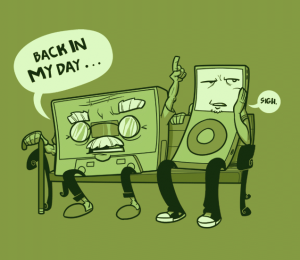
With a warm moment of nostalgia, Warnock reminds us of the longstanding notion of the writing teacher persona, “sitting in a café with papers stacked neatly on a table, quietly reading, and then writing comments by hand” (p124). All that is missing is the tanned classic leather satchel to complete the image in my mind’s eye. It is a nice thought and I certainly remember those days.
I do enjoy the integration of technology and I fully support Warnock’s notion that the digital landscape affords us many new opportunities to explore writing and student engagement.
The integration of digital tools has fundamentally changed how we can operate and interact with learners. Whether you are teaching an F2F class, hybrid, or fully online, I have seen teachers at all levels integrate many of these wonderful new technologies by necessity. That is, in many ways this new paradigm for teaching was inevitable given that more and more of our students are “digital natives” (Prensky, 2001) and we strive to continue making our lessons both real and relevant for them today.
For my F2F classes, I give the option for students to write by hand and/or by computer (most use computers). For my hybrid classes I integrate the Google suite/ Adobe products through a CMS. For both types of classes, I have always provided my global commentary in a digital format because I type over 100 wpm and my handwriting, well, based on what I’ve been told of my penmanship, I could have been a doctor. Naturally, I still collect papers and write notes in the margins, but I try to do as much as I can digitally. Macros and rubber-stamping have not worked that well for me as I tend to enjoy writing personal remarks to each student.
I actively implement many of the ideas presented by Warnock in regards to grading/ quizzes and rubrics. In particular the use of quizzes to provide a structure for students as they work through the materials.
Now that I’ve established my fondness for technology, there is one thing that truly remains a challenge for me and takes me back to the days of having a leather tanned satchel filled with essays in a café. That is, the face-to-face exchanges and the information that transpires when people interact with each other directly. I know that there are many great tools out there that we can use from voice threads to videoconference, but for me they still fall short. Perhaps it is rooted in my Waldorf education experience, but I feel very strongly about face-to-face social interaction for humans. So, there is my dilemma and I look forward to learning from all of you how I might be able to bridge that concern.
Dragon NaturallySpeaking:
I have not used this tool as of yet, but I’ve heard much about it and I can’t wait to try it. I’m excited to see what I might be able to do with it and how my students respond. I’ll gladly provide my thoughts on it soon. Is this the same program that the writing center is using?
Skype/ WhatsApp / Zoom:
Of all of these I’ve found WhatsApp to work the best for students and me. It’s free and all that is required is a WiFi signal to connect anywhere on the globe. They all allow you to add documents to the conversation, etc. etc. and provide an opportunity for face-to-face communication.
Google Suite:
Google Docs / Google Groups / Google Voice (text/call) / Google Hangouts (video/chat/text) Synchronous editing is great for student collaboration and for editing documents with students. Has features for editing directly or simply making suggestions (like notes in Word). Google products can be integrated into your CMS if features are not already built in.
Inserted Spoken Comments:
Yup, have tried this. Never quite got into this one. Just seems a lot easier to type a comment in the notes / margin. I do like the idea of recording global summary feedback on writing projects.
Phone:
I know some teachers give out their personal phone numbers. I don’t. I’ll gladly text or have a call with a student, but we’ll use a 3rdparty provider like WhatsApp or Skype.
Podcasting:
I have created podcasts in the past, particularly as a world language educator, but have not yet applied the technology to my writing classes. Podcasting is best suited for long-form content but I’ve used it for 10-15 minute introduction and overviews of projects and lessons. I’ve also used it successfully (I thought) for literature reading review projects. Although podcasting does not solve my issue with the lack of the face-to-face teaching component, I do think it goes a long way in building a genuine connection with your audience instead of one that might feel a bit lackluster and distant.

